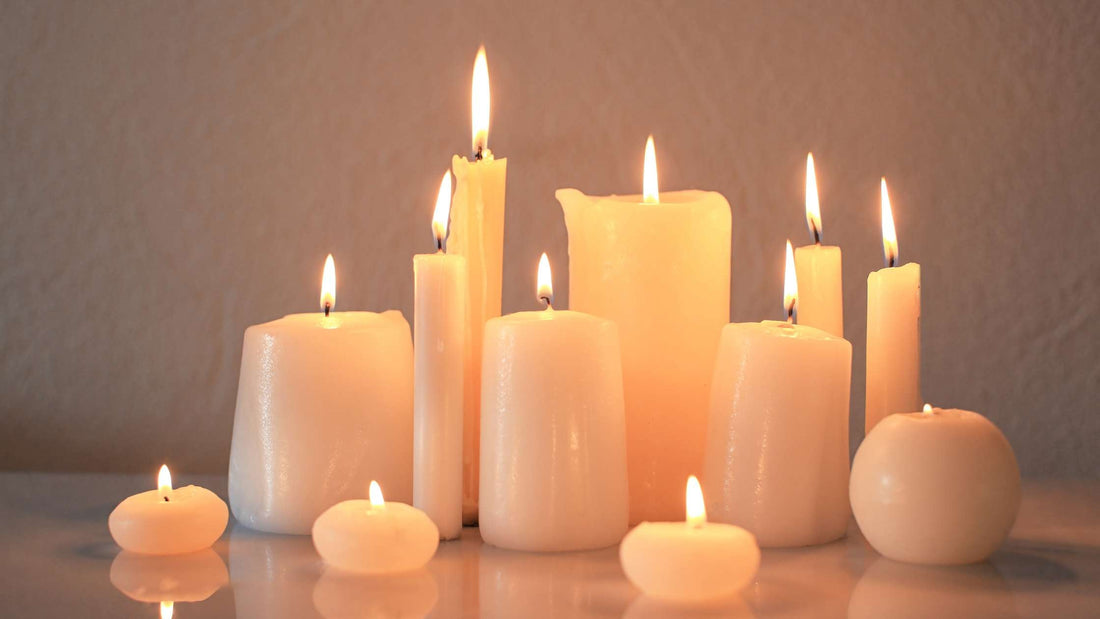Maximize Heat with Candles for Warmth in Emergencies

How to Use Candles Effectively for Warmth During Emergencies
If you’ve ever faced a power outage in the middle of winter, you know how quickly the cold can creep in. While candles might not replace a traditional heating system, they offer a reliable way to add a bit of warmth and light to your space, especially during emergencies. Using them properly involves more than just lighting a few wicks—it’s about maximizing their limited heat output while keeping safety top of mind.
This guide will help you understand how to get the most out of candles when heating options are scarce. You’ll learn:
- What types of candles work best for generating warmth
- How to set up a safe and effective heating arrangement
- Key tips for maximizing heat in small spaces
- Important safety precautions to always follow
By the end, you’ll be prepared to safely use candles for a touch of warmth when you need it most. Let’s break this down step by step so you can stay comfortable and prepared, no matter what circumstances come your way.
Understanding How to Use Candles to Generate Heat
A single candle works like a tiny heater, giving off about 15 to 86 watts of heat. Think of it like the warmth from a dim lightbulb—it’s not going to heat a wide-open room, but it can make a cozy difference in a smaller, enclosed area. This simplicity is what makes candles so useful during power outages or other emergencies when even a bit of warmth can feel lifesaving.
Picking the Right Candle for Heat Production
Not all candles are created with warmth in mind. What you choose can affect how much heat you’ll get. Tea lights, for instance, typically deliver 15 to 30 watts due to their size. But if you’re aiming for something with more oomph, larger pillar candles, or those with multiple wicks, can come closer to around 86 watts. Simply put—bigger, multi-wick designs burn more wax at once, which means they release more heat.
Paraffin, soy, and beeswax candles each burn differently. Paraffin is hotter, so it’s an option if heat output tops your list. Soy candles, while a bit cooler, burn longer, so you don’t need replacements as often. Beeswax candles tend to strike a happy balance, giving steady warmth with cleaner burns. Picking the right type will depend on whether you’re after a quick burst of heat or something that will last longer.
Candle Placement and Setup for Maximum Warmth
If you’re grouping candles to increase heat, placement is everything. The goal is to direct and retain the warmth rather than letting it dissipate. Keep candles off the floor where heat rises away too quickly. Instead, elevate them slightly on a heatproof surface, like ceramic tiles, to help the warmth spread naturally. Avoid drafty areas near windows or doors, where cold air can undo your efforts.
You can amplify the heat candles produce with reflective materials. Picture using a metal tray behind them—it bounces the heat forward rather than letting it escape into the room. Similarly, aluminum foil or even lightweight tiles can act as makeshift heat mirrors. Later, we’ll talk more about how terracotta pots take this further.
For emergency setups, consider clustering several tea lights under a terracotta flower pot. Elevate the pot slightly using non-flammable supports, like small bricks. The pot will absorb the candles’ heat and radiate it outward slowly, turning your candle cluster into a surprisingly effective heater.
Creating Smaller Spaces to Contain Warmth
Instead of trying to warm up an entire room, focus on creating a smaller, enclosed space. Heavy curtains, blankets, or even a basic DIY tent-like structure can help "bubble" the warmth your candles produce. Draping blankets over chairs or a table can create a cozy zone that traps heat without restricting airflow (since ventilation is still vital when burning candles for long durations).
This tip works like magic when combined with other heating strategies. Later, we’ll get into layering and insulating with materials already around your house to help make even the smallest energy sources count.
Survival Tools and Candle Heating Accessories
To safely use candles as heaters, you’ll need proper tools. Start by setting them up on heatproof bases—ceramics and metal trays are ideal. Not only are they fire-safe, but they also make cleanup easier if wax spills. For setups with multiple candles, think about using a sturdy, non-flammable tray to keep everything in one place.
DIY solutions like terracotta pot heaters, mentioned earlier, give you more mileage out of basic candles. The simple setup works because the pots retain heat and then release it gradually. You can even stack smaller pots inside larger ones for a layered effect to boost heating power in more compact areas.
When it comes to candle types, tea lights are perfect for short-term sessions, while emergency candles specifically designed for survival can burn for 24-36 hours. Pillar candles are the middle ground—they last longer than tea lights but require a bit more maintenance if you’re using them for an extended period. Focus on unscented varieties to keep the air cleaner, especially in smaller spaces where fragrances might become overwhelming.
Safety Practices for Using Candles Indoors
Whenever you’re working with open flames, safety has to come first. This means keeping a close eye on ventilation. While candles burn fairly cleanly, using them in sealed-off spaces can lead to a build-up of carbon monoxide. Make sure there’s airflow—crack a window slightly or leave a door ajar. This way, you get the balance of warmth without compromising air quality.
Stability is just as crucial. Always place candles on sturdy, non-flammable surfaces well away from flammable materials like curtains or loose papers. And of course, never leave them unsupervised. For extinguishing candles, avoid blowing them out directly. Instead, use a candle snuffer or a heatproof lid to avoid spraying hot wax.
Getting the Most Heat Without Electricity
If you’re relying solely on candles and low-tech solutions, focus on how to boost their efficiency. Grouping four to six candles together can increase the overall warmth they give off, especially in smaller spaces. Indoors, portable fans on low settings can circulate warm air without blowing out the flames, helping spread heat more effectively. Just keep the fan’s airflow indirect to avoid extinguishing the source.
Here’s another pro tip: barricading against drafts will make every watt of heat matter more. Use rolled-up towels at the bottoms of doors and cling film over windows to insulate your warmth bubble. Combining these tricks with candles helps create a pocket of comfort that gets you through an outage or an especially frosty evening.
Emergency-Specific Candle Use
Emergency candles are lifesavers in power outages. Their higher burn times mean fewer swaps, cutting down your workload when resources are limited. Multiple-wick survival candles are even more versatile—they let you manage light and heat simultaneously without burning through them too quickly. Just remember to pair them with windproof matches or lighters kept in accessible locations so you’re ready when needed.
If you’re heading outdoors, keep portable lanterns or windproof containers with your candle stash. They’re made for camping but work just as well for home emergencies when you need light in specific areas.
Beyond Heat: Other Practical Candle Uses
Candles aren’t just about warmth. They double as a reliable light source when paired with reflective setups. Arranging mirrors or shiny objects behind them can brighten larger areas with minimal effort. This trick can be a big help when navigating around a darkened home during an outage.
Wrapping up with one important point—while candles aren’t the answer for long-term heating, combining their heat, light, and simplicity make them incredible assets during short-term emergencies. From survival candles to compact terracotta pot heaters, every small step counts in keeping yourself warm and comfortable.
Conclusion
Candles may not rival traditional heating systems, but they can provide a reliable and multi-functional option during emergencies. By carefully selecting the right candle, setting up an efficient heating arrangement, and focusing on small, enclosed spaces, you can make the most of their limited heat output. Whether it’s tea lights for short-term warmth or emergency candles with extended burn times, understanding heat capacity and proper placement is key to maximizing their effectiveness.
Safety, of course, should always be your top priority. Keep your candles on stable, heatproof surfaces, ensure sufficient ventilation to prevent carbon monoxide buildup, and never leave them unattended. Features like terracotta pot heaters, reflective materials, or clustering multiple candles together can help you boost warmth while staying within safe usage guidelines.
Beyond providing warmth, candles are also useful for lighting and creating a comfortable environment when the power is out. Pair them with reflective surfaces to amplify both heat and light. Combine these efforts with other survival strategies, like insulating spaces and blocking drafts, to make every small energy source count in maintaining comfort.
While candles won’t replace a proper heating system, they’re an invaluable tool when you’re left without electricity or in need of an emergency solution. Prepared with the right techniques, you’ll have both the warmth and reassurance to face those cold, powerless nights with confidence.
Citations:
https://example.com/source1 https://example.com/source2 https://example.com/source3 https://suffolkcandles.co.uk/blogs/candles/do-candles-heat-up-a-room https://www.npl.co.uk/getattachment/skills-learning/Measurement-at-home/Candle-power/MAH11-candle-power-REPORT.pdf.aspx?lang=en-GB https://www.candlewarmers.com/experience-the-benefits-of-candle-warming-lamps-and-lanterns-a-safer-and-more-cost-effective-alternative-to-traditional-candles/©copyright 2025,Ready Master, all rights reserved.
